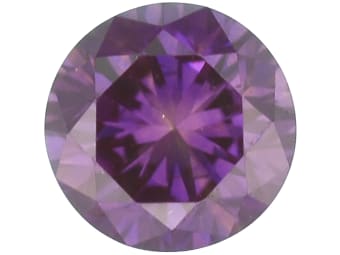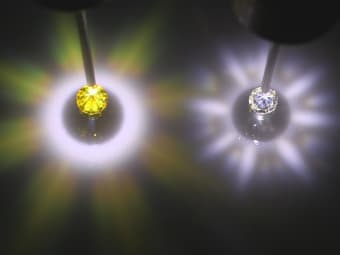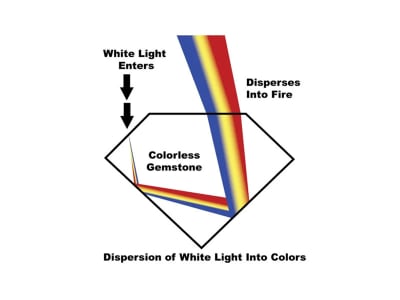Have you ever seen a rainbow when looking at a gemstone? This rainbow-like display of color is known as gemstone dispersion or as a gemstone's "fire." Gemstone fire, or dispersion, is the result of white light traveling through a gemstone at different speeds. The different wavelengths of light "disperse" when exiting the gemstone, creating the rainbow color display. Each gemstone has its own dispersion value; however the cut, size, body color and shape of the gem influence how well you can view the dispersion.
How can gemstone dispersion be classified?
A gemstone's dispersion may be classified as not observable, moderate, strong or very strong.
- A measured dispersion value less than 0.017 is classified as "not observable." Examples of gemstones with no observable dispersion are Quartz (0.013) and Glass (0.010).
- Dispersion values ranging from 0.017 to 0.050 are classified as "moderate." Diamond (0.044) is a gemstone with a moderate dispersion value and is the gem most noted for its "fire."
- Dispersion measured 0.051-0.071 is classified as "strong." Demantoid Garnet (0.057) is an example of a gem with strong dispersion.
- Gemstone dispersion values greater than 0.071 are classified as "very strong." Synthetic Moissanite (0.104) has very strong dispersion.
How is gemstone dispersion measured and calculated?
The dispersion of a gemstone can be measured because gems have a refractive index (RI) for each wavelength of light. Gemologists use a refractometer to calculate the gemstone dispersion by taking the difference between the red (687 nanometers) and violet (430.0 nanometers) refractive indexes. This is expressed numerically with higher numerical values representing greater dispersion.

Both natural and synthetic gems can show dispersion, however it may be masked by the stone's body color if the saturation is moderate or stronger or if it has a dark tone.
Gems with higher refractive indexes tend to exhibit greater dispersion because they bend light to a greater degree. This happens when light travels through a transparent gemstone and it refracts or bends.
The spectral colors that make up white light travel at different speeds and when they bend, they begin to separate. Faceted gems are cut to reflect light internally as much as possible, before it exits the gem through the crown. The longer the light is refracting through the stone, the greater the separation of colors and the stronger the observed fire will be.


